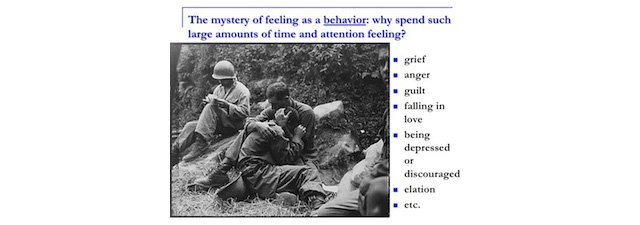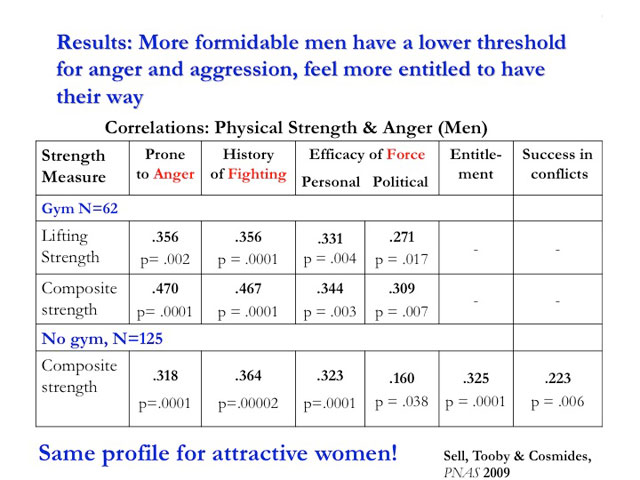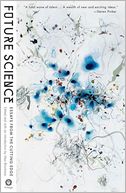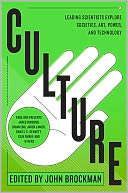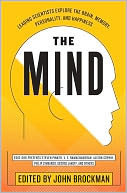And that was the inspiration for this project that we've been working on for several years. And I have to thank three people in this room for us having the resources to do this: Mike Gazzaniga and Steve Pinker for having recommended us for the award that we got to do this, and Anne Treisman because Anne was on this very intimidating interviewing board for this award, and she was not repelled by it apparently because we got the award, and it's given us the freedom to pursue this topic, and I'll show you a sort of thin slice of what we've been doing. And I won't go always into the details of the data, because the overview, the vision of this, is the more interesting thing. But I'll show you some data
The question we started with was, there's a mystery of feeling, as a behavior. Why do we spend so much time and attention feeling: grief, anger, guilt and so forth?
This is a picture from the Korean War, and what you're seeing here is this man has just seen his buddy killed, and he is being comforted by this man. This man [on left] is filling out casualty tags for people who are already dead. There are computations going on in all three heads, presumably. With the cognitive revolution, the kinds of theories that people were coming up with, had a lot to say about the computations going on in his [man on left's] head, but very little to say about the kinds of computations that were going on in the other two heads.
You ask this question, why do we anger, grieve, want to help, want to hurt? Our intuition says, well because you feel like it. And yes, of course you do. But what we wanted to know is, can you move beyond this barrier of intuitions and subjective descriptions, and get more purchase on this kind of question?
What we've been pursuing is the idea that what generates these feelings is a layer of neuro-computational procedures and representations—what we're going to call internal regulatory variables—devices that compute them, and decision rules that these variables feed. And that these cause us to feel certain very specific motivations and value-specific outcomes and express certain kinds of behaviors, given certain inputs. And that this is actually map-able at this point in time.
There were some ways of thinking about motivation, drive reduction theories, reinforcement theories, goal seeking models, and theories of preferences and so forth. All those have some merit to them and can account for certain phenomena, but there's a large range of phenomena that just doesn't fall naturally into any of those kinds of accounts: anger, love, jealousy, guilt, gratitude, depression, incest avoidance, disgust, status striving. There were a lot of different things that you'd want to be able to think about, that are central to human nature, but these kinds of theories don't really help you with.
We thought we needed to have different kinds of ways of thinking about the problem. The cognitive revolution had provided this new way of thinking about the brain and the mind, where every organ has evolved to serve a certain function: the heart pumps blood, et cetera. The brain's also an organ, and at the most general level, its evolved function is to extract information from the internal and external environment and use that information to generate behavior and regulate physiology. From this perspective, the brain's a computational device, a physical system that was designed to process information.
From this point of view, to describe the brain's operation in a way that captures its evolved function, you need to obviously think about it as composed of programs that process information, which requires theories that are expressed in information-processing or computational terms.
I just want to emphasize that this isn't a poor sister of neuroscience, this isn't what you do until neuroscience gets better. Because presumably, the reason that certain kinds of neural circuits were retained by natural selection and others discarded, is because of the computations that they created. This information-processing level is really essential for understanding what these neural circuits are doing.
And that was a very powerful insight that had turned the study of perception and attention, memory, reasoning, and learning, into a real science. But it had been barely applied to the study of motivation. You ask yourself, what's the impediment? Why not?
We thought it was the lack of theories of what motivational systems were designed to do. So—for each reliably developing species-typical program in the brain—it was designed by natural selection to solve a specific kind of adaptive problem. For perception, memory, things like this, the nature of the problems being solved seemed clear. They turned out to be more complicated than people thought, but they seemed a little clearer, and some had analogs in computer design, or the operation of a camera; how people think about the eye and things like this.
But what were social motivational systems designed to do? What kinds of adaptive problems were they designed to solve? To answer this, you need theoretical guidance from evolutionary biology, from the kinds of theories that Martin was talking about today.
In evolutionary biology and behavioral ecology, there are a lot of formal models that are specifying very interesting adaptive problems that arise in social life. Martin talked about kin selection, which has to do with resource division within the family. There are ones that have to do with dominance and status-striving. There are ones that have to do with reciprocation and reciprocal altruism. There are a number of these models. Our notion was that we wanted to use these theories as theoretical guidance to have models of what are the functional outputs of a motivational system, and then use the methods of cognitive sciences to actually try to see if there were mechanisms that were designed to solve these problems. And then we wanted to also dissociate computation from phenomenology because in motivation, the phenomenology of different kinds of motivation is so compelling. When you're feeling angry with somebody or you're feeling disgusted or frustrated, the phenomenology of that is very compelling.
But of course the phenomenology of vision is very compelling, too. Vision really started to make progress when people dissociated the phenomenology from the study of the computations—with the notion that eventually you'll put them back together again. But taking—as an empirical strategy—trying to understand vision as a computational system, really let the study of vision make a lot of progress. And eventually, one hopes it will all be put back together again, and we hope the same. We're taking the strategy of trying to understand motivational systems as computational systems, and hopefully at some point we'll be able to understand the phenomenology as well.
In our case, what we always do in our research, John and I, is we start with a task analysis, or what David Marr would have called a theory of the computation. It seemed to us that the kinds of programs that are necessary to solve motivational problems require computational elements that didn't correspond to the kinds of things cognitive scientists usually think about. They weren't beliefs; they're not concepts; they're not desires, preferences, drives; but something else that we're going to call internal regulatory variables and the specializations that compute them and deliver them to decision-making systems. Our working hypothesis is that motivational systems are interpenetrated by a network of these computed regulatory variables.
The idea is that there are these internal regulatory variables—you're familiar with them from the study of physiology. Because physiology is just replete with regulatory variables: your blood glucose level drops, and that triggers certain kinds of hunger and food-seeking responses; your nose gets stuffed in the pillow, and your carbon dioxide to oxygen ratio goes up too fast, and it triggers a suffocation alarm response so that you try to get out of the pillow. These are internal regulatory variables for physiological processes.
We thought that there should probably be internal regulatory variables in the same sense for social motivations. And so these would have evolved to track particular properties of the body, the social environment, and the physical environment—whose computation provided inputs needed for evolved decision rules. These internal regulatory variables have magnitudes, and they express value, or else they provide input to mechanisms that compute value.
We've been interested in a lot of them. I'm going to talk a little bit about welfare tradeoff ratios, and the kinship index. But there are things that index your formidability, prestige status, reciprocity (are you a good reciprocator, which is crucial to things such as indirect reciprocity), which group am I a member of, coalition, and there should be a lot of different internal regulatory variables.
I'm just going to talk about two today. I'm going to briefly talk about the work that we started out with on the biology of kinship, which is directly related to the kin selection theories that Martin Nowak referred to, and then something called a welfare tradeoff ratio, which has to do with when you make the decision to trade off your own welfare to enhance that of somebody else's. Then I'm going to talk about recalibrational emotions, the idea that certain emotions' functions are to recalibrate other regulatory variables, like the welfare tradeoff ratio. And I will show you data about that.
So kin detection system: This is with our colleague, Debra Lieberman. Ancestrally, there was intense selection to avoid mating with close relatives. This is a very bad thing to do for various reasons including deleterious recessives coming together at greater rates. There was also kin-selected helping. Kin selection in a species like our own should have selected for mechanisms for making certain kinds of tradeoffs between our own welfare and that of close kin.
Now, notice that these are two very different adaptive problems: avoiding having sex with your kin, versus when should you help your kin. But one element of a solution to both is common, and that is you need to know who your kin are. Who are these relatives? Solving both of these problems requires some kind of human kin detection system, which you can think of as a neurocomputational system that's well engineered, given the structure of ancestral environments, for computing which individuals in your social environment are close genetic relatives. Our notion was that they should compute what we're going to call a kinship index, which is an internal regulatory variable that feeds into systems regulating sexual preference and avoidance and helping behavior.
The idea is that this regulatory variable, this kinship index, its magnitude should index the degree of genetic relatedness of specific other individuals to yourself. It should regulate a motivational system that causes sexual attraction, and one that motivates helping others. When my kinship index for a particular other person, say my sister, a female child in my environment, or brother, is high, a high kinship index should down-regulate sexual attraction by activating disgust at the possibility of sex with a family member, and it should up-regulate motivation to provide aid.
That implies that there has to be some mechanism that computes kinship indexes, and let's call it a kinship estimator. A mechanism, that computes kinship indexes for the individuals in your immediate social environment. But there's an engineering problem, which is you can't see somebody's DNA. The design solution would have to be something like: base that kinship index on cues that we evolved mechanisms to monitor because they were stably correlated with genetic relatedness in ancestral environments.
Then you can ask the question: ancestrally, what would make the detection of differential relatedness possible? Organisms inherit their genes from their parents, and their mating decisions and patterns of association generate structured patterns of association among individuals in their local environment. The system would need to use observable cues that were correlated with relatedness, ancestrally. What might those be?
Let me just a say, there's a little learnability issue: A domain-general—a completely blank slate—system wouldn't really be able to learn this. You could say, well, why can't you just use local transient cues from the environment, like kin terms (somebody calls somebody my brother, and so forth) to learn this? But there's a problem because, to deduce which cues locally predict relatedness, the system would have to already know who it was related to, to know which cues predict that, and that's exactly what the system is designed to figure out.
What might be ancestrally reliable cues? Well, one we gave the fancy name “Maternal Perinatal Association.” Basically, given that I have mechanisms for knowing who my mother is (like maybe who took care of me as an infant, whatever it might be), anybody who comes out of her body is probably my sibling, right? Or is my sibling.
It's very likely that anybody that I see my mother nursing or taking close care of as an infant, there's a very high probability that that neonate is a sibling, at least a half-sibling, of mine. And actually, even in Santa Barbara, if you ask people about all their different siblings, their full-, half-, step-, and adoptive siblings, being present in the home—MPA, this cue—being present in the home when this sibling was born), is actually correlated .88 with whether they're full-, half-, step-, or adoptive siblings.
But of course, this cue is only going to help oders identify their younger siblings. Time doesn't run backwards. If I'm a younger, I can't use this to identify who my siblings are. For younger siblings, their mind has to be using a different kind of cue. The one that we were interested in had a long history. It was first proposed by the Finnish sociologist, Edward Westermark, and it's duration of co-residence during childhood. So when I was a child, how long did I co-reside with a given individual.
Hunter-gatherer bands, at different seasons they come apart and then they come together again. When they fission and fuse again, nuclear families tend to stay together. During your childhood years, the longer that you've stayed together with somebody the higher the probability it is that that person is a full sibling. Even in Santa Barbara today, the degree of kinship with siblings is predicted by the co-residence duration, .71. It's a good cue, even today, of who's your sibling.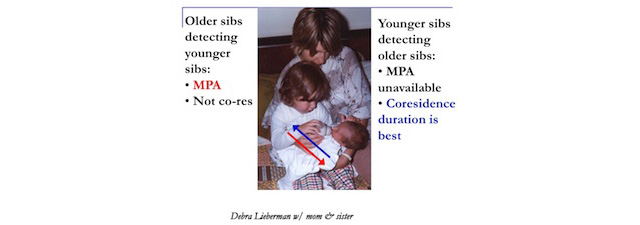
(This is Debra when she was a baby, and her little sister, Amy, and her mother.) The idea here is that older siblings detecting younger ones can use this maternal perinatal association cue, and they don't even have to use co-residence. They're going to get a good purchase on who their siblings are just from that cue alone. To anticipate what I'm going to show you, if you have the MPA cue, your levels of disgust at sex with that person and your levels of altruism toward, or helping of that person, are high, regardless of how long you've co-resided with them.
On the other hand, this baby here, Amy, she doesn't have access to the MPA cue for Debbie, and so for her, the system should default to this other cue, of co-residence duration. There was evidence about co-residence duration from other studies that used populations where the people were not actually genetic relatives. One of the most famous examples being Joseph Shepher's work on the Israeli kibbutzim where you have these crèches, and children are not actually related to one another, but they would grow up loving these other people dearly, but not wanting to have sex with them, and not wanting to marry them, and so forth.
Well we wanted to ask: what about regular family situations, and what about more direct measures of psychology and behavior? The idea was that we wanted to look for a converging evidence of a kinship index in the following way: it should regulate these two very distinct motivational systems. If it exists, it should regulate a system governing altruistic behavior, and a system governing sexual aversion. And then we wanted to identify the cues that are used to compute this kinship index by quantitatively matching individual exposure to cues like MPA and duration of co-residence (and we looked at other cues as well) to variation in your altruism toward your sibling, and also how repulsed you are by the idea of sexual contact with your siblings.
The idea being that if this kinship index exists, then the same developmental parameters, like MPA and co-residence duration, should regulate both systems in the same pattern.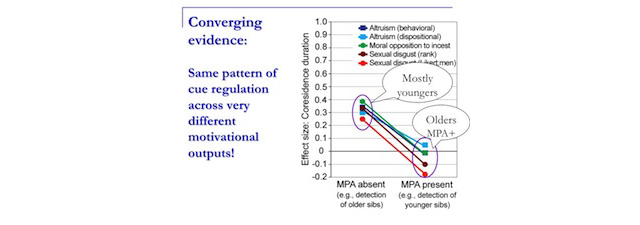
The short version is that that's basically what we found. We created very detailed surveys to get at exactly how many years you co-resided with each of your siblings, and all kinds of things about that. Then we asked things like how many favors did you do for them in the last month? Would you be willing to donate a kidney to them? We asked a lot of things about moral opposition to sibling incest as a more unobtrusive measure of disgust.
We had the most disgusting questions ever created on a questionnaire, like how disgusting—or appealing—would it be to tongue-kiss your sister or your brother, or to have sex with your sibling? (Steve has a sister, he's going uhhh! Pardon me for saying that.) And what we found was: This is the effect size—this is how much co-residence duration (how long you co-resided with a particular sibling)—to what extent does it predict your altruism toward that person and your disgust at sex with that person. (This is like an r; it can go between one and negative one.) And what you see here is that—for people who have no access to the MPA cue (who are mostly youngers talking about their older siblings)—you're finding that these all sit on top of each other; that there's a very nice correlation between how altruistic (how many favors you did, all these different measures) and how disgusted you are at sex with them: co-residence duration and these measures for these guys. And for these people (who are mostly olders, who have access to the MPA cue), there's no correlation: co-residence doesn't predict anything.
Let me just tell you without showing you oceans of data because I want to go out into welfare tradeoff ratios, that if the MPA cue is present, your levels of altruism towards your sibling and your level of sexual disgust was high. And it's unaffected by co-residence duration. It's a non-compensatory use of cues. Interesting.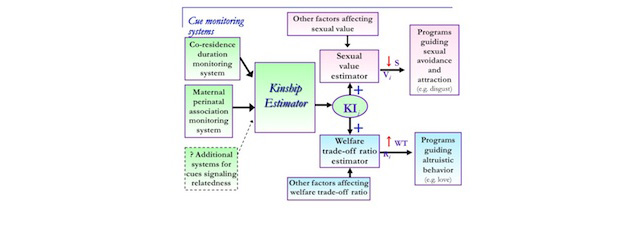
The system that we're imagining is something like this: you have cue-monitoring systems (some systems that are counting up years of co-residence, and were you present when this baby was born, and there might be other things that we don't know about yet). They're feeding into this kinship estimator. It gives out a kinship index for each particular individual in your local environment. There's a system, a motivational system that involves welfare tradeoffs, that I'll talk about in a second, that it feeds into. When your kinship index is high, that's going to increase the amount you're willing to sacrifice your own welfare for somebody else's, for that person's, and it's going to feed into these programs for making those kinds of decisions.
At the same time, there's going to be this other motivational system that has to do with sexual avoidance and sexual attraction. There's a lot of research in evolutionary psychology and other branches of social psychology about what makes somebody attractive as a mate. But it doesn't matter how attractive a woman or a man is as a mate, if they're your brother or sister, that's just a deal-breaker, right? So with the kinship index, if it's high it feeds into here, it's going to decrease that person's sexual value to you, even though they might have a high sexual value to somebody else. And it's going to activate disgust. That's the picture that we're looking at. This is the kind of thing that I mean when I'm talking about what it would mean to start to unpack this in a computational way, these regulatory variables.
To move back to feelings: the idea is that feeling is a special form of computation. This is going to be so unromantic, I can't even tell you how unromantic this view is.
Feeling is a special form of internal regulatory value recalibration. There should be a lot of these different regulatory variables, and valuation and allocational decision-making requires a lot of them to make tradeoffs between potential alternatives. New information should trigger this ramifying recalibration through the system. Things like the death of a loved one, falling in love, being defeated in a fight, finding out your mate's been unfaithful—all of these things are important for how you weight that other person in your social world, and how you're going to behave towards them.
More difficult than discovering what's true is discovering what should be valued. The idea is that these internal regulatory variables should be continuously subject to change and require recalibration all the time on the basis of new input and new information from your social world. So, this is the truly romantic part of it. You could think of it as, feeling as a kind of computation: a giant system of matrix algebra, with these sets of variables undergoing this continual transformation with respect to each other from other kinds of operators in your head, activated by new information.
There's still a puzzle of phenomenology. Why does that recalibrational process have to be experienced? I don't have the answer to that. It could be that it was originally designed for perceptual input. It could be that posting information to a sort of central place, where it could be accessed by many mechanisms. There could be many reasons. I can't answer that. But for some reason, this recalibration process often requires, not always because the kinship index doesn't, but some of these require input through some kind of conscious awareness. It takes time and attention. And hopefully, we'll be dead, but somebody will figure that out at some point: why? That puzzle remains. But the idea is that we evolve to live in the sea of feeling.
Thank you very much.
Q & A
STEVEN PINKER: One thought. This relates to the conscious awareness of the recalibration, internal regulatory variables. That is, when you have the output of a language computation. That is, someone says something to you, and you add it to your database, and that's also very conscious. And obviously that has a huge impact in, say, calibration of behavior. If I tell you that someone else did something to your detriment that would make you angry in a hurry. Likewise, If you read a "Dear John" letter, all kinds of language input can cause a very instant calibration.
What role do you think it has in the kinship index, in particular? Particularly when, say, you're Bill Clinton and you discover you have all these half brothers, or you're Oedipus and you discover that your wife is actually your mother. There's a lot of dramatic fiction that takes as its plot device the sudden revelation of some motivationally salient information and how it in your terms recalibrates one of these variables.
JOHN TOOBY: The very interesting thing is that, the role of consciousness suggests it's justnecessary for carrying out at least some of the recalibrational computation required by new information. . We think feelings are signals broadcast through consciousness about changes in these regulatory variables, okay? So that …
LEDA COSMIDES: Sometimes ...
JOHN TOOBY: ... our data show that the intensity of conscious feeling, such as anger, predicts the magnitude of the downstream changes in these non-conscious variables. People put a lot of time into, you know, seemingly functionless behavior—just feeling in response to personal news. When something important happens, they go off to be by themselves, and they take time to feel about it—so we think the function is revising their motivational weightings. But we don't have any science on the linguistic interface to consciousness right now.
LEDA COSMIDES: But that doesn't speak to Steve’s question about what happens when you are told, as an adult, that someone is your sibling..
JOHN TOOBY: I just wanted to say we don’t know how the interface operates. ... In our data, when evolved cues of kinship conflict with linguistically supplied information, it is the cues that prevail in determining responses.
LEDA COSMIDES: Here are things we know. We know that, when you have a step-sibling or an adoptive sibling—so you know that they're not actually your genetic relative. Your altruism and sexual disgust is predicted very well by your duration of co-residence with them, implying that there's a non-conscious computation generating those things, because you know. We asked them, and you believe them to be not your kin. And that's consistent with kibbutz studies and so on.
JOHN TOOBY: People who as infants aregiven up, and …
LEDA COSMIDES: But what we do know You mean shim-pua marriages?
JOHN TOOBY: … who are adopted, and then they're reunited as adults with their birth families. And one of the things which is not widely reported on, is that significant numbers of them report strong sexual attraction to their family members. So linguistic information doesn’t carry the same impact as co-residence cues.
LEDA COSMIDES: ... Debbie's actually been an expert witness at a number of trials. Because sometimes these people get prosecuted.
STEVEN PINKER: Oh, they're thrown in jail.
LEDA COSMIDES: Yes. As adults, they meet their sibling and they fall in love, and then they get thrown in jail, and so Debbie has sometimes been an expert witness in these cases. I don't know how general the phenomenon is. It's one of those things that's so rare that it's hard to study systematically. And also, for a person, it kind of depends. For example, I have no siblings, and if you were to ask me these questions, my reaction to, like, brother/sister incest, if I imagine having a brother, would completely depend on whether I analogize it to my cousin, or to my father.
Because these are about the only analogs I have. If it's my cousin, it's like, he's kind of cute. I don't know. I don't have any particular aversive reaction to it. If it's with my father, oh my God, that's, like, one of the most disgusting things, you can not make a questionnaire with something more disgusting to me than that—I mean, there could be sewage systems involved, and ingestion…that's so much better than sex with dad. …
STEVEN PINKER: It's curious which of these internal variables are cognitively penetrable, and which isn't. On the other hand, we know studies by Daly and others, the kinship metaphors, such as we're all a band of brothers, we're a big family, that demonstrably has effects of increased solidarity. And very simply, the verbal toleration for, we're all brothers, that does seem to make a difference.
LEDA COSMIDES: Yes. it's hard to know. That's why there was a box on our little model that's for other kinds of inputs. All that we can say so far is that these two variables do have an effect, and they have the same pattern for the two different motivational systems. I can't tell you whether there are other ones.
STEVEN PINKER: This is more of a historical comment than a question, but your case for internal regulatory variables was actually made quite explicitly, elegantly, in the early '50s by Neil Miller, in response to a denial of the existence of internal regulatory variables by B.F. Skinner.
It actually crystallizes your argument very cleanly. Skinner said, "Why do we need concepts like thirst, when thirst is unobservable, it's subjective? It's therefore not scientific. Science should only be about things that you could measure, observe and manipulate." So, instead of invoking this mystical concept of thirst, all a science of behavior needs to say is that, if you deprive an animal of water for so many hours, it will work harder to obtain water as a reward. That's all that thirst is.
And Neil Miller responded and said, no, no. That's not right. Because there's actually a whole list of things that you can do, such as turning up the temperature, feeding the animal salt, tying its salivary ducts. There's a whole bunch of things that will happen in response, such as consuming more water when it's available ad lib, preferring foods with a higher water content. If you were to list a bunch of "if, then" statements, manipulate this, and this is how the animal behaves, you need, in your theory, M times N laws where as with the theory that evokes thirst as an internal regulatory variable, you just need M plus N. So by the principle of parsimony, it's actually more scientific to posit the internal variable.
Moreover, you get a much more powerful set of empirical predictions, because if I do add some operation to the list, like feeding a diuretic to the animal, and I observe that it will work harder for water, I can also predict, before having done the experiments, that it will also prefer food with a higher water content, drink more water, et cetera. I'm making correct, falsifiable predictions.
By a second criterion, it's also more scientific rather than less to posit this unobservable hidden variable. It seems to me that its quite analogous to the argument you're making for internal variables as a construct of location.
LEDA COSMIDES: Yes. You've also made an argument. Paul Bloom believes that the three of us have been all bruised by our encounters with behaviorism.
And that we keep going back to these arguments.
STEVEN PINKER: Still refuting Skinner.
LEDA COSMIDES: Exactly.
STEEVN PINKER: I will dig up the article.
LEDA COSMIDES: Thank you. That's great.
DANNY KAHNEMAN: I have a question and an observation. The question is, what happens in the animal world? Every biological reason that you have for kin, for avoidance of incest and so on, that doesn't apply to humans. …
LEDA COSMIDES: Animals have a lot of different ways. It depends on the species how they do it. For example, mammals that are born in litters, sometimes use the smell of their littermates that makes somebody sexually unappealing to you. Or, some animals do it by their dispersion patterns. It might be in some species that the males, when they become juveniles, in a lot of primates, the males will leave, and so forth. There's many different ways of avoiding incest and avoiding inbreeding with your kin. It depends on the species and their particular behavioral ecology which one natural selection has settled on, but it's not necessarily this.
This method is much better for species where you have offspring that are born at different times, as opposed to in a litter, for example.
DANNY KAHNEMAN: As an observation, the amount of care that people show for disasters shows a very clear, very steep geographical pattern. That is, you really care about things that happen to people on your street, and then in your city, and so on. There seems to be that mechanism, which is …
LEDA COSMIDES: There's also mechanisms that, one thing that we've done has to do with that there's a lot of data from the animal world that start out with nice models of dominance interactions, and ability to accept harm through violence. With the asymmetric war of attrition, Parker and Hammerstein have done a lot of research on that, and we've applied this to people, because that should be a variable, that should matter too, even though we live in a very pacified society, as Steve was showing, and we have these pacified UCSB undergraduates, right? They're pretty pacified folks. And we got their actual strength of their upper body strength that the gym, on these machines, and, it turns out, first of all, that you can tell people's strengths from looking at them. Men's strength, not women's. But women and men are equally good at doing this, about men. You can, from a face alone. tell men's strength. They can be Bolivian hunter/horticulturalists and you could do it.
DANNY KAHNEMAN: It predicts voting?
LEDA COSMIDES: Let me show you what happens here. The idea is that, the more you can inflict harm, the more other people should defer to you. And the more you should expect them to put weight on your welfare, right? And so, you should expect a high welfare tradeoff ratio from other people. There should be a larger set of things that should annoy you, that should anger you, right?
We're finding that their [men's] strength was predicting how prone they were to anger, their history of fighting, how efficacious they think force is in settling interpersonal disputes, how entitled they feel to good treatment, their success in resolving conflicts of interest—not even aggressive, but just any conflicts of interest in their favor.
And also—we did this to rule out a rational choice explanation—because you could think, oh, maybe, with a history of fighting you've experienced being able to do things like punch somebody out. But, your flexed bicep circumference on your dominant arm has nothing to do with the efficacy of the American military. But it predicts something about how efficacious you think political force will be as well. You find the same profile actually for attractive women, which is very interesting.
You find the same sort of thing along the Bolivian hunter/horticulturalists. Here, you ask people, "Who are the most angry people around here? Who gets angry the most easily? Who has the most social influence? Who has the most allies?" You get all these peer ratings from other people. And, we got their actual physical strength, and it predicts how easily they anger, how much social influence they have in the group, how many allies they have.
And then also, in terms of putting together these different variables, their anger is independently predicted by both how many allies that they have and their individual strength. There are a lot of interesting parallels with other animals.
JIM GILES: I'm wondering, how are these variables represented neurologically?
LEDA COSMIDES: Oh, God. Mike has to answer that. I don't know. I know when it comes to time discounting there's been some neural work on time discounting, and some other kinds of regulatory variables that are now conveniently escaping my mind.
In terms of these things, what I can tell you is based on very preliminary work. I can tell you that it's a different part of the brain so far. But it's very preliminary, because we haven't finished, but what lights up when people are making these welfare tradeoff decisions is a different part of the brain than lights up when making time discounting decisions, even though the time discounting has a sort of similar flavor to it. Like, less money now or more money later and so forth. It's a different part of the brain. I don't remember which, and I wouldn't put much store in it yet anyway, because we're not done.
Mike is obsessed with the question, and rightly so, of how does the brain represent anything? But the idea would be that there's a part of the brain that this welfare tradeoff function, that it exists as a real system in the brain, and that it's taking in these different factors and computing them. Where it is? How it works? I don't know.
STEVEN PINKER: For some of these, they sound very hormone-y. They may not be a part of the brain, but perhaps a circuit that's sensitized or regulated by serotonin, or oxytocin, or testosterone.
LEDA COSMIDES: It would be nice to sort of squirt some oxytocin up people's noses, and Mike told me we can now do that at UCSB.
STEVEN PINKER: Testosterone seems to attract, certainly, a dominance challenge.
LEDA COSMIDES: Actually, the actual physical strength as measured in the gym does a better job of predicting these variables than basal testosterone.
JOHN TOOBY: These effects cannot just be due to testosterone. These effects are much bigger than testosteroneeffects.
LEDA COSMIDES: A different possibility, we'll talk about 'roid rage. They assume that it's a steroid effect. But it could be that you're building up all this muscle mass, and that that's what's priming violence, not steroid use. Which means that it’s a mistake having these prisons with all this weightlifting equipment in it. They should have them jazzercising or something, instead of lifting weights. There could be modulation by different hormone systems. I just don't know that.
JARON LANIER: You mentioned vision studies earlier. We tend to think of machine vision systems as requiring feedback that reinforces both positively and negatively depending on how well the vision system is performing. For instance, one way is based on whether the system of is able to make correct predictions of what is about to be seen, what a face should look like as the angle of observation changes, for instance. But there could also be positive feedback generated because of completion of a task that required vision.
The interesting thing is that there's an ambiguity about whether feedback was generated because of accuracy or effectiveness or some other criteria. No system can store everything. At some point the reasons a system evolved in a certain way must be lost.
In the human brain, is there ultimately a difference between a quality or memory that was reinforced by emotion or something else?
And that's very interesting to me, because in the language of vision science, we don't talk about emotional feedback very much, but we could.
STEVEN PINKER: For example, look at this slide as I make it out of focus and try to read it now. It's kind of annoying. There was a little drop of pleasure from putting this in focus.
A lot of visual aesthetics in photography and landscape painting as kind of maximizing what I take to be an internal regulatory variable of visual pleasure, which I'd like to think correlates with …
DANNY KAHNEMAN: There is a lot of evidence of a very close link between cognitive fluency and mood. That's that people's ability to connect with their own intuition is completely gone in bad mood, and really increases when mood is good. There are experiments in which people are presented triads of words, which may or may not be associatively related. When they are related cognitive fluency increases and an incipient smile is observed, even when people cannot articulate the connection.
If you're curious I can provide the references.
LEDA COSMIDES: This is an homage to Danny’s work on judgment under uncertainty. We've been interested in the notion of adaptationist game theory, not just evolutionary game theory. Taking seriously that there's a cognitive architecture that has certain properties, and then letting those properties evolve . (See: "The evolution of direct reciprocity under uncertainty can explain human generosity in one-shot encounters.")
There's been all this stuff with generosity in one-shot games, and why is it happening? Lots of people say, oh, you need group selection to explain it. . What we did here was—this is an agent-based simulation. We took seriously the judgment under uncertainty problem, of whether you're in a one-shot situation, or a repeated situation. Because in real life, God's not telling you, right? In real life, if I meet you once, not 'til the moment I die will I know for sure that that was a one-time interaction. Life is long and so, we have to estimate this probability.
We've modeled this in two different ways, and got the same answer in both ways. In one case, we made the belief system perfectly Bayesianly rational. We gave our little agents perfect information about what the base rate of one-shot and repeated interactions was in their little world.
And then, your partner would have a cue, a specific numerical value associated with it—and there was a distribution associated with it--for whether it was a one-shot or repeated partner.. It was associated with, like I said, in a signal detection way, with overlapping curves. Then you compute, using Bayes' rule, you compute a belief about whether this is going to be a one-shot or repeated interaction.
Then what's allowed to evolve is a cognitive variable that has to do with your disposition to cooperate given that you believe that it's a one-shot interaction. It turns out that if you only have two repeated rounds, on average, then nothing happens. But there can be five, 10 rounds, which is not very much in a small hunter-gatherer band, in real life. The probability of cooperating, given that you believe—rationally believe—it's a one-shot interaction becomes very high very quickly. The idea is that these were internal regulatory variables.
Then we did it, and it turns out that its even true if the base rate of repeated interactions is as low as 10 percent. It might be only 10 percent—90% of the interactions are one-shot—and you still get this.
And we did it a different way, where we allowed the belief system to evolve. Here, if you believe it's one shot, then you defect, and if you believe it's repeated. then you cooperate. But, how much evidence do you need before you believe that it's repeated? And it's virtually none. You evolved to have …
DANNY KAHNEMAN: People tend to be quite insensitive both to base-rates and to the quality of evidence; they will jump to conclusions from one observation.
LEDA COSMIDES: Exactly. It doesn't take very much until you believe that it's one-shot. Repeated, rather.
DANNY KAHNEMAN: That's another very general find.
LEDA COSMIDES: Yes.
DANNY KAHNEMAN: It takes very little information. And even if the information is of very poor quality, you make the best story out of the limited information you have.
And you act on it.
LEDA COSMIDES: Exactly. This is natural selection acting on these agents and designing their cognitive architecture in the way that's going to maximize their fitness. Usually people don't ask those cognitive questions when they're doing the game theory. They don't ask, "How do you know it's one-shot?"
JOHN TOOBY: The larger significance is that economists and others have found that people appear far more cooperative than is rational. And this motivated people to explain this apparent adaptive mistake through group selection models, or complex gene-culture coevolution models.
LEDA COSMIDES: Yes. All of our agents are tit for tatters.
JOHN TOOBY: Well, here, this work shows that pretty much whenever you're in the part of parameter space in which cooperation or or reciprocity evolves, the evolution of cooperation carries with it a halo of excess generosity. And therefore, you don't need cumbersome explanations for why humans are generous cooperators. The answer is that the dynamic favoring generosity comes directly from the evolutionary dynamics of reciprocity itself. If your species is going to develop reciprocity, then you are going to develop a generous form of reciprocity.
LEDA COSMIDES: Well, and for a very good reason, which is, the two mistakes have different payoffs. Because if I think it's a repeated interaction and it turns out to be one-shot, yeah, I have a little cost at first, if I'm a Tit for Tatter, but then I don't after that. Then again, if I think something's one-shot and it's really repeated, I'm missing out on a whole relationship of beneficial interactions.
JOHN TOOBY: It's just a simple signal detection analysis. In order to avoid the really costly mistakes, of alienating what otherwise would be valuable long-term relationships, you just assume against all evidence and against base rates that it might be repeated, so you don’t treat it as a one-shot. The mind should be designed to be generous, even when it looks like a one-shot.
Return to Edge Master Class 2011: The Science of Human Nature
|
"We'd certainly be better off if everyone sampled the fabulous Edge symposium, which, like the best in science, is modest and daring all at once." — David Brooks, New York Times column
Future Science, edited by Max Brockman 18 original essays by the brightest young minds in science: Kevin P. Hand - Felix Warneken - William McEwan - Anthony Aguirre -Daniela Kaufer and Darlene Francis - Jon Kleinberg - Coren Apicella - Laurie R. Santos - Jennifer Jacquet - Kirsten Bomblies - Asif A. Ghazanfar - Naomi I. Eisenberger - Joshua Knobe - Fiery Cushman - Liane Young - Daniel Haun - Joan Y. Chiao "A fascinating and very readable summary of the latest thinking on human behaviour." — [More]
"Cool and thought-provoking material. ... so hip." — Washington Post The Best of Edge: The Mind, edited by John Brockman 18 conversations and essays on the brain, memory, personality and happiness: Steven Pinker - George Lakoff - Joseph LeDoux -Geoffrey Miller - Steven Rose - Frank Sulloway - V.S. Ramachandran - Nicholas Humphrey - Philip Zimbardo - Martin Seligman -Stanislas Dehaene - Simon Baron-Cohen - Robert Sapolsky - Alison Gopnik - David Lykken - Jonathan Haidt For the past 15 years, literary-agent-turned-crusader-of-human-progress John Brockman has been a remarkable curator of curiosity, long before either "curator" or "curiosity" was a frivolously tossed around buzzword. His Edge.org has become an epicenter of bleeding-edge insight across science, technology and beyond, hosting conversations with some of our era's greatest thinkers (and, once a year, asking them some big questions). Last month marked the release of The Mind, the first volume in The Best of Edge Series, presenting eighteen provocative, landmark pieces—essays, interviews, transcribed talks—from the Edge archive. The anthology reads like a who's who ... across psychology, evolutionary biology, social science, technology, and more. And, perhaps equally interestingly, the tome—most of the materials in which are available for free online—is an implicit manifesto for the enduring power of books as curatorial capsules of ideas. "(A) treasure chest ... A coffer of cutting-edge contemporary thought, The Mind contains the building blocks of tomorrow's history book—whatever medium they may come in—and invites a provocative peer forward as we gaze back at some of the most defining ideas of our time." — [More] The Best of Edge: Culture, edited by John Brockman
17 conversations and essays on art, society, power and technology: Daniel C. Dennett - Jared Diamond - Denis Dutton - Brian Eno -Stewart Brand - George Dyson - David Gelernter - Karl Sigmund - Jaron Lanier - Nicholas A. Christakis - Douglas Rushkoff - Evgeny Morozov - Clay Shirky - W. Brian Arthur - W. Daniel Hillis - Richard Foreman - Frank Schirrmacher We've already ravished The Mind -- the first in a series of anthologies by Edge.org editor John Brockman, curating 15 years' worth of the most provocative thinking on major facets of science, culture, and intellectual life. On its trails comes Culture: Leading Scientists Explore Societies, Art, Power, and Technology—a treasure chest of insight true to the promise of its title. From the origin and social purpose of art to how technology shapes civilization to the Internet as a force of democracy and despotism, the 17 pieces exude the kind of intellectual inquiry and cultural curiosity that give progress its wings. (A) lavish cerebral feast ... one of this year's most significant time-capsules of contemporary thought." —[More]< |


